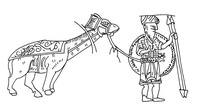Battle of Stilo
| Battle of Stilo | |||||||
|---|---|---|---|---|---|---|---|
 Warrior of the Fatimid / Kalbid period 11th century Sicily | |||||||
| |||||||
| Belligerents | |||||||
|
Holy Roman Empire Principality of Benevento | |||||||
| Commanders and leaders | |||||||
|
Emperor Otto II Landulf IV of Benevento † Pandulf II of Salerno † | Emir Abu'l-Qasim † | ||||||
| Strength | |||||||
| 2,100+ armored cavalry, the rest unknown | Unknown | ||||||
| Casualties and losses | |||||||
|
4,000 killed including many nobles | Fewer than Imperial army | ||||||
The Battle of Stilo (also known as Cape Colonna and Crotone) was fought on 13 or 14 July 982 near Crotone in Calabria between the forces of Holy Roman Emperor Otto II and his Italo-Lombard allies and those of the Kalbid emir of Sicily, Abu'l-Qasim, who had declared a holy war against the Germans. Some sources claim that the Muslims received support from the Byzantines, in retaliation for Otto's invasion of their province of Apulia, but this is unconfirmed[citation needed].
Pitched battle
[edit]Abu'l-Qasim was not far from Rossano Calabro when he noticed the unexpected strength of Otto's troops, and retreated. Tipped off to the retreat by ships[clarification needed], Otto left his wife Theophanu and their children in Rossano, along with the baggage and the imperial treasure, and set off to pursue the enemy. When Abu'l-Qasim recognized that he would not be able to flee, he readied his army for a pitched battle at Capo Colonna, south of Crotone. After a violent clash, a corps of German heavy cavalry destroyed the Muslim centre and then pushed towards the emir's guards. Abu'l-Qasim was ultimately killed during the battle, but his troops were not shaken, going on to surround Otto's forces with a hidden reserve of approximately 5,000 cavalry and[1] inflicting heavy losses. According to Ibn al-Athir's history, casualties numbered around 4,000, among them Landulf IV of Benevento, Henry I, Bishop of Augsburg, Günther, Margrave of Merseburg, the Abbot of Fulda, and 19 other German counts.[2] Otto was forced to flee the battle, ultimately securing shelter only by swimming out to a Byzantine merchant ship.[3][4] He then rested in Rossano, only returning to Rome on 12 November 982.
Election of Otto III
[edit]After fleeing northward, Otto held an assembly consisting primarily of local magnates in Verona. There, he secured the election of his son as King of Italy and called for reinforcements from Germany. Saxon losses in the battle had been the most severe, and Duke Bernard I of Saxony had been heading south to Verona for the assembly, but raids from Danish Vikings forced him to turn back. Otto had sent his nephew Duke Otto I of Swabia and Bavaria north to Germany to deliver the news of the battle at Stilo, but the Duke perished en route. Nevertheless, word did travel, reaching as far as Wessex—a testament to the magnitude of the disaster. Ultimately, Otto would die the next year before being able to resume the campaign in southern Italy.
Succession in Capua, Benevento, and Salerno
[edit]The Mezzogiorno was shaken by the battle. With Landulf and his brothers Atenulf and Pandulf II of Salerno having died fighting, the holdings of Capua and Benevento passed on to cadet branches of the Landulfid family—with Salerno ultimately being snatched up by Duke Manso I of Amalfi.
Consequences in Southern Italy and the Elbe
[edit]Although the Kalbid troops had been forced to retreat back to the island of Sicily, the Muslims retained a presence in southern Italy, continuing to harass local Greeks and Lombards. Additionally, when the Slavic peoples living on the Elbe heard of the emperor's defeat, they immediately rose up against imperial suzerainty in what would ultimately prove to be a decades-long setback for efforts to Germanise and Christianise them.
Notes
[edit]Sources
[edit]- Barkowski, Robert F. (2015). Crotone 982 (in Polish). Warszawa: Bellona. ISBN 978-83-11-13732-5.
- Reuter, Timothy. Germany in the Early Middle Ages 800–1056. New York: Longman, 1991.
